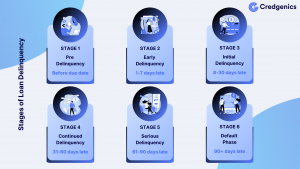Understanding loan delinquency is crucial in today’s dynamic financial services ecosystem as loans play a vital role in most people’s lives. Whether it’s a personal loan, credit card, home loan or vehicle loan, lenders expect timely repayment of credit through agreed monthly instalments. Missing these deadlines impacts a borrower’s financial well-being and credit rating.
By knowing more about loan delinquency – its causes, consequences, and solutions, both lenders and borrowers can make better informed decisions. This capability empowers people to manage their debt responsibly while providing a sustainable lending environment.
What is Loan Delinquency
To better understand the concept, let us simplify loan delinquency. Loan delinquency occurs when the borrower fails to make scheduled loan repayments. When the borrower misses one or more payments, they are considered delinquent. This can happen with any type of loan, including personal, home, or auto loans.
For example: Danish took out a personal loan with a monthly payment due on the 5th of every month. However, due to some unexpected expenses, he falls behind on his loan payments. The lender designates his loan account as delinquent when he misses two consecutive monthly instalments. Usually, the lender will make an effort to get in touch with the borrower to inform them of the overdue payment.
Statistics on Delinquencies
Delinquency rates for India’s digital lending industry stood at 4.2% in the financial year 2023, according to a report by the Fintech Association For Consumer Empowerment (FACE) and credit rating agency Equifax. Furthermore, a study by FACE shows that 3.6% of loans issued by fintech companies through digital platforms were overdue for more than 90 days as of September 2023.
Common Causes of Loan Delinquency
Several reasons can lead to this situation, including:
Unexpected Expenses: Unforeseen events, such as medical emergencies, can strain borrowers’ budgets and impact their ability to make timely loan repayments.
Loss in Income: A significant decrease in income, due to job loss, or business downturn, can make it challenging for borrowers to meet their loan obligations.
Poor Financial Management: Inadequate budgeting, overspending, or mismanagement of funds can result in borrowers lacking the necessary resources to keep up with their loan payments.
Technology Issues: In some cases, borrowers may encounter technical difficulties or payment processing issues when attempting to make repayments. This factor leads to unintentional delinquency.
Lack of Awareness: Borrowers may miss repayments due to a lack of understanding or awareness of the due dates, repayment amounts, or the fact that a repayment is due at all.
Recommended Read: Collection as a Service: A Comprehensive Guide
Different Stages of Loan Delinquency

Stage 1 – Pre Delinquency (Before Due Date)
At this stage, the payment is not yet due, but the lender may send reminders or notifications to the borrower about the upcoming due date. This is a proactive approach to encourage timely payment.
Stage 2 – Early Delinquency (1-7 Days Late)
The borrower has missed the due date by 1 to 7 days. The lender may send gentle reminders to understand the reason for the missed payment and offer assistance if needed.
Stage 3 – Initial Delinquency (8-30 Days Late)
The payment is still outstanding for 8 to 30 days. The lender may send more frequent reminders, make phone calls, or offer payment plans or restructuring options.
Stage 4 – Continued Delinquency (31-60 Days Late)
The borrower has missed two consecutive payments. The lender may consider legal action, engage a collection team, or initiate foreclosure or repossession for secured loans.
Stage 5 – Serious Delinquency (61-90 Days Late)
If the delinquency persists beyond 60 days, the lender may exhaust all possible collection efforts, initiate legal proceedings and report the delinquency to credit bureaus. This severely impacts the borrower’s credit score.
Stage 6 – Default (90+ Days Late)
If the borrower fails to make any payments for 90 days or more, they are considered defaulters. At this stage, the lender has likely initiated legal action to recover the money owed to them.
Consequences of Loan Delinquency for Borrowers
Loan delinquency can have severe and long-lasting impacts on borrowers. Here are some of the implications:
Credit Score: Missing loan payments can lower a borrower’s credit score. Delinquency makes it difficult to obtain future credit, secure housing, or qualify for favourable interest rates.
Late Fees & Penalties: Lenders typically impose late fees on delinquent accounts, which increase the overall amount owed to borrowers.
Loss of Collateral: For secured loans, such as auto loans or mortgages, continued delinquency can lead to repossessing the collateral asset, such as a car, house, or other property.
Legal Consequences: In some cases, lenders may take legal action against delinquent borrowers, thereby harming their reputation in society.
Recommended Read: How Customer-Centric Communication Transforms the Borrowing Experience
Effective Strategies for Lenders to Minimize Loan Delinquency
Loan delinquency can be a major pain point for lenders. When borrowers miss payments, it impacts the lender’s profitability and increases the risk of defaults. Thus, in order to avoid delinquencies, lenders need to communicate with borrowers clearly and offer support. Here are some effective tactics:
1. Provide Clear Communication and Repayment Information
Lenders must ensure that borrowers are always aware of their payment status – how much they have paid, how much they still owe, and when their next payment is due. Leverage SMS, email, WhatsApp, IVR, voice bots, or chatbots to send accurate and timely information. This helps borrowers stay on track with their payments.
2. Make Digital Payments Easier for Borrowers
Offer convenient and instant payment options, especially for borrowers who are willing or attempting to pay. Here, custom payment links are a great solution, allowing borrowers to repay their loan EMI instantly using their preferred payment methods, such as UPI or card.
3. Establish Clear Payment Reminder Strategies
Send reminders ahead of due dates to reduce the likelihood of missed payments. Lenders should use multiple contact methods, such as SMS, email, or a friendly phone call but ensure they have permission to contact the borrower through these channels. Additionally, reminder schedules should be customized based on the risk of delinquency.
4. Consider Loan Modifications
For borrowers facing true financial hardship, offer options to modify loans, such as extending the loan term or temporarily reducing interest rates. This strategy can make repayments more manageable and help get delinquent payers back on track.
In Conclusion
Open communication and a supportive approach are key to reducing loan delinquency. Lenders must provide clear repayment information, enable simple digital payments, implement data-driven reminder strategies, and offer flexibility through loan modifications when needed. By implementing these strategies, lenders can enhance borrower experience and significantly reduce the incidence of loan delinquency.

Frequently Asked Questions (FAQs)
1. How to Prevent Delinquency?
To avoid delinquency and maintain a high credit score, take several proactive steps:
- Schedule monthly payments to ensure that due dates are never missed.
- Closely monitor your expenses to ensure sufficient funds are available for upcoming payments.
- Request the lender to adjust due dates to align with the pay dates for easier management.
2. What’s the Difference Between Delinquency and Default?
Delinquency refers to a situation where a payment is late or missed shortly after the due date. It is an early stage of payment issues. Defaulting, conversely, is a more severe situation where a borrower fails to meet the payment terms for an extended period of time. This situation often leads to legal action and a significant negative impact on the borrower’s creditworthiness.
3. What Happens if a Loan is Defaulted?
If a borrower misses payments for 90 days or more, the loan is typically considered in default. At this stage, the lender may initiate legal proceedings to recover the owed amount. This default status significantly damages the borrower’s credit score and makes it harder for them to obtain credit in the future.





